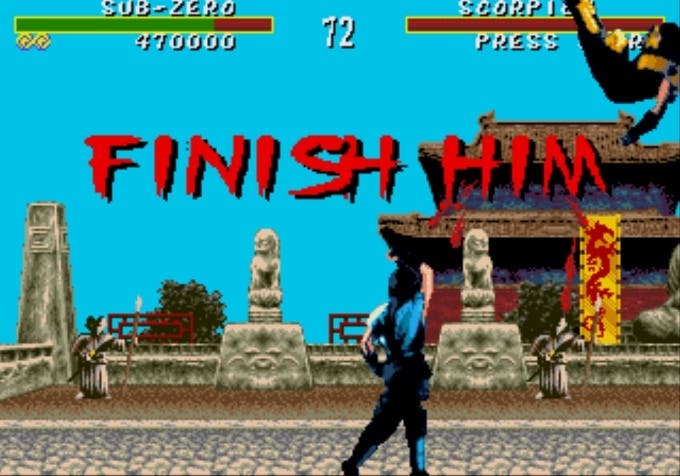Mortal Kombat: Blood and Money
A look back at Midway's infamous fighter.
But while the sales techniques were cynical, the belly of the original beast wasn't too healthy either. Once feverishly unlocked with trembling hands, the much talked about crimson splatterings were, well, a bit naff. Blood would squirt out in massive great globs whenever a powerful blow was landed, regardless of whether it was especially likely to have caused such damage. Every character was a huge walking artery, ready to start leaking at any moment. Whenever a fighter had their heart yanked out it was symbolically grotesque, but also rather silly due to the standard-issue cartoon droplets gushing from the corpse - at odds with the digitally rendered appearance. Whether this humorous streak was intentional or not is hard to say. Later games played up the lighter angle of fatalities (kisses which inflated people's heads until they burst, deadly arcade machines falling from the sky, that manner of business), but the original title was a relatively dark affair. Taken at face value, the finishing moves were all pretty grim - with little to lighten the mood except how weird they seemed when overlaid with red blobs.
Just the seven pints for me then
As mentioned, one of Mortal Kombat's more innovative aspects was the approach to fighter design. Rather than knocking together some animated warriors from pure imagination, digitised versions of real actors performing various moves were transposed onto traditional fighting backdrops (dungeons, temples and the like). This succeeded in generating additional hype, but had some accompanying problems. Most obviously, it meant that the combatants were of similar size and were all basically humanoid, resulting in something of a lack of variety. Especially with Scorpion and Sub-Zero being little more than a palette-switch with slightly different moves. It's probably no coincidence that the character who gained most attention was the imposing, four-armed Goro - based on a Ray Harryhausen style model rather than a real person. Further to this, the game fell foul of the issue suffered by many early dabblers in the realism/impressionism dichotomy: the characters looked fairly convincing (especially at a distance), but they don't always react terribly realistically during play. This is less noticeable in titles where the art direction is self-consciously fictional, but becomes far more apparent when the controllable character is 'real.'

The 'weight' of the game, at least, was generally terrific. When a body slammed into the floor after a successful flying kick, the screen jiggled supportively to enhance the illusion of a mighty blow. Perhaps it was just my imagination, but the Amiga conversion felt the chunkiest of all, with every connection supported by an appropriately meaty sound effect. Although the same praise couldn't be applied to the blocking, which tended to result in the characters just sliding rather unconvincingly off one another. The paucity of 'falling over in defeat' animations was also rather glaring; anyone struggling to complete a finishing move in time would be rewarded by the defeated competitor suddenly flinging themselves to the ground after a period of groggy swaying.
Al Gore
Overall balance, too, was a bit off. Mortal Kombat moved away from the 'circle sweep and button press' school of special moves - instead branching out into all kinds of fancy sequences. Unfortunately, this just meant certain lengthier moves (such as Sub-Zero's ice-flinging trick) became rather unsafe to attempt against skilled enemies, real or artificial. Characters whose specials could be whipped out with ease, such as Raiden or Scorpion, had something of an advantage. As too did anyone who figured out that cautious, defensive play with a great deal of blocking was the way to success when in a tight spot. Not the most encouraging discovery, unless you're a fan of more strategic slogs. Despite all of this, the massive popularity of the opening games in the series resulted in a large, brand-loyal fan-base and a collection of releases which are now in double figures. Some people just can't get enough of those fatalities.

Yet the discrepancy between conversions makes the original Mortal Kombat's 2D fighter credentials tricky to assess. Only the Amiga version stands up as a great transfer, and this had as much to do with the lack of other fighters available to owners of Commodore's beige machine (the only realistic alternative being Body Blows). However, the game perhaps represented a tipping point for the sophistication of the game-buying public. Today, it's difficult to imagine such an average console conversion getting as easy a ride, or racking up the sales that Mortal Kombat did, purely on the strength of blood and mystique. Tacky marketing techniques will always exist - but while the majority of gamers (though perhaps not the censors) are mature enough to accept violence and sexuality when presented in a convincing context, eyes now begin to roll if a title is hyped on the back of nothing more than controversy. Not quite a case of 'won't get fooled again', but surely a move towards 'won't be fooled so easily'.